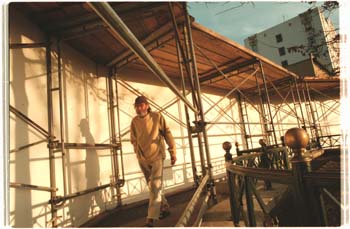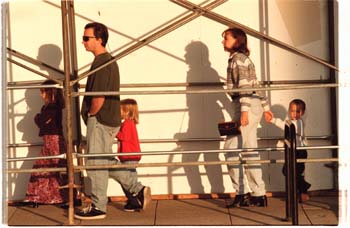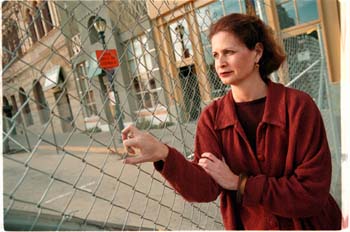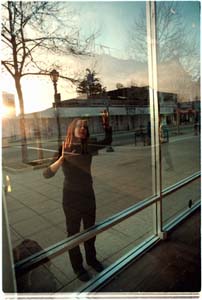![[MetroActive News&Issues]](/gifs/news468.gif)
[ Metro Santa Cruz | MetroActive Central | Archives ]
Surviving Prosperity
The Road Back: The return of the Cooper House, rising behind this scaffolding, will be the jewel in the crown of the revival of downtown Santa Cruz since the Loma Prieta Earthquake. The Palomar Hotel looms in the background.
With the Loma Prieta earthquake receding into the past, downtown merchants look to the future. Will they reap the benefits of revitalization?
By Sarah Phelan
WITH A FEW NOTABLE EXCEPTIONS, the gap-toothed grin of missing storefronts in downtown Santa Cruz has gradually been filled in. At the corner of Pacific and Cooper, a steel-girder skeleton serves notice that the most prominent symbol of the rebirth of downtown, the new Cooper House, could be ready in time for the 10th anniversary of the Loma Prieta earthquake this October. Downtown Santa Cruz appears, at first blush, to be back on its feet.
But it is also a time of uncertainty and change. Downtown is in transition, and in the business community feelings of hope mix with anxiety. For property owners and managers, the payoff for years of struggle and rebuilding may finally be within view. But many small business owners, particularly retail merchants, fear that the revitalization poses a greater threat to their survival than the quake did.
Small shops are being squeezed out by rising rents, and there is a shortage of office space. Citing the recent arrival of Costco, Cost Plus, Office Max and Ross on the outskirts of downtown--as well as the abrupt liquidation sales of several longtime small businesses--some merchants fear that the unique spirit of Santa Cruz could be homogenized by the new business climate.
The construction of the new Cooper House, the University Town Center at Pacific and Cathcart, and the Redtree Properties building at 1200 Pacific promises that traffic and parking problems are about to get a lot worse. Meanwhile, the recent closure of Cooper Street during the early construction phase of Cooper House was seen by many as symbolic of a City Council more interested in courting big business than nurturing small operations.
Will these changes result in a more vibrant downtown, providing new jobs and new revenues, or will the changing face of Santa Cruz create a new system of winners and losers--and if the latter, who will decide? Banks? Property owners and developers? Voters and their elected representatives? Consumers through their spending habits?
Santa Cruz is undergoing a major transition. Can Santa Cruz maintain its unique character or are small local merchants canaries in the commercial coal mine, living life in a bubble that is about to burst?
Street Level
THE TENTS ARE LONG GONE. All that remains of the earthquake's destructiveness are a couple of undeveloped lots, cordoned off by chain-link fences and colonized by pampas grass. Soon even these sites will vanish as construction crews roll in to complete the last of the redevelopment. For the merchants who survived the quake--which killed three people, destroyed 20 buildings and displaced some 50 businesses downtown--the memories remain vivid.
The rebuilding has paved the way for changes prefigured by the box stores on River Street.
"Before the earthquake, we had this meandering Garden Mall," says Caffe Bene owner Ken Botelho. "Now even the lines in the sidewalk are straight ... [and] only the corporate world can afford the rents the landlords are asking."
Kathleen McBurney, co-owner of the recently closed Cat N' Canary, knows what he means. She and her business partner, Julie Hendee, survived the quake, but when the lease expired at their Pacific Avenue location last year, their landlord, Jerome Friedman, raised their rent from $5,500 to $12,000 a month.
"He's a nice man from San Francisco," McBurney explains, "but when local real estate agents told him he could get double the rent for the space, he went for it."
Not everyone agrees that retail on Pacific is strong enough to support such hikes--at least not during the tourist-challenged winter months. And so far there is no new tenant for the Cat N' Canary space.
"Pacific Avenue is a terrible place to do retail," believes Lisa Finklestein, who recently closed her downtown Rue Des Anges store to relocate to Los Gatos. "Tourists would buy my clothes, but the rest of the year locals would confess that they loved my stuff but couldn't afford it."
Still, what makes merchants nervous is that if new retail tenants are found at the higher rates, it will set the tone for future rent hikes. Many merchants are holding their breaths, especially those near the end of their leases.
Tom Teiffer, who relocated his women's apparel store from Front Street a couple of years ago, also found that his downtown clients were mainly tourists, but he says that did not influence his decision to move. "Business downtown was fabulous, but our new location next to Gayle's Bakery in Capitola is even better," he says.
However, he's convinced that the market in downtown Santa Cruz is picking up.
"Now that the town has got the clock-tower end of things right, it's restored people's faith that this town is not just about a bunch of hippies," Teiffer says. "In a couple of years, Santa Cruz will be the place to do retail."
Board Walk: Downtown shoppers will soon have several new shops to choose from. But will they be chains or local merchants?
Price of Success
IN 1997, DOWNTOWN SALES finally surpassed pre-quake levels--and did so without the millions of dollars in sales revenues that the downtown Gottschalk's, Ford's and auto dealers used to bring in for the city. But news of a burgeoning economic recovery is cold comfort to merchants like McBurney, who struggled through the lean post-quake years only to find themselves priced out of the market.
"We're the victims of our own success," McBurney says. "It's hard to face being brushed aside now that things are getting up and running again."
McBurney didn't give up immediately. She looked for another place on Pacific and managed to negotiate a lease on one-third of the old Woolworth's location. But the day the lease was to be signed, she was notified that the landlady, Santa Cruz-based Gloria Welsh, had gone with a national tenant.
McBurney believes that Welsh, who is already leasing the neighboring property to The Gap, wanted the financial stability that a national tenant brings. Welsh denies this, but confirms that Gap Kids has surveyed her third of the Woolworth's lot. McBurney chose to liquidate rather than go elsewhere.
"The feeling among downtown merchants these days is one of fear--that the revitalization of Santa Cruz will lead to a chain-store invasion," says Stuart Martin. He's been in business downtown for 25 years and owns the successful Integrand Design. "Right now, all the businesses downtown are nervous, whether they sell clothing, shoes, sportswear or crafts, because they know they're going to get competition. They ask me how I've coped since Cost Plus arrived."
Martin says the wholesaling giant hasn't hurt his store. "It just made me make some changes. A little competition is healthy." But he has fears about the long-term effects of the chains on the health of business downtown.
"We're seeing the same trend across the country," Martin continues. "The Costcos, Cost Pluses and Wal-Marts move into the city outskirts, and the inner city gets abandoned. I find it hard to believe that the Redevelopment Agency doesn't see this. But I do understand that they see the potential for huge sales tax revenues from these big chains."
The city, Martin says, should provide incentives for small businesses to occupy the new retail spaces under construction.
Though he feels secure about his rental arrangement--he has a long-term lease with a local landlord--he's less confident that incoming retailers won't be in direct competition with existing stores.
According to Redevelopment Agency head Ceil Cirillo, the only contractual restriction on Cooper House developer Jay Paul is that he not lease space to a national bookstore. And though Redtree Properties project manager John Tremoulis told the Santa Cruz County Sentinel on May 29, 1997, "I don't want to see a bunch of national chains downtown," Martin says he will believe that when he sees it.
"The city promised there would be nothing in the Gateway project to compete with downtown stores," he says, "but two years later Cost Plus came in."
Adding to Martin's suspicions is the fact that Redtree is now pushing hard for a Borders Books and Music store in its Capitola Crossing development. Cirillo says Redtree is still looking for big tenants for its 1200 Pacific building.
Knight in Shining Armor?
MARTIN IS NOT THE only one who has lost faith. Jamy Kulp is one of four women who bought into the now-defunct Folk Arts six years ago. She soon discovered, like Finklestein, that doing retail on postquake Pacific was tough, and got even tougher during the El Niño winter of 1998. Her business went heavily into debt, and she fell behind on the rent.
Her landlord, developer Barry Swenson, declined to renew the lease, going instead with an expansion by next-door neighbor Pacific Wave. By November, Folk Arts was gone, leaving Kulp and her partners $72,000 in debt.
Property manager Eric Morris says that Swenson, who owns about a quarter of downtown's best property, "isn't in the business of booting people out or jacking up rents.
"He doesn't try to pull tenants from outside," insists Morris. "If the market went through the roof, he would want to keep up, but he wouldn't initiate that situation."
Bookshop Santa Cruz owner and former Mayor Neal Coonerty has a 25-year lease with Swenson. The unofficial granddaddy of downtown business, Coonerty says that in some respects, Swenson is a hero, because he helped finance major buildings when no other developer was willing to take the risk.
"Within a year of the Loma Prieta earthquake, Gottschalk's, Ford's and three banks had closed, and it took five years for the Coast Commercial Bank to finance a deal," Coonerty says. "But Swenson did it when the land was dirt cheap and with the help of low-interest loans from FEMA [the Federal Emergency Management Agency]. His actions weren't all altruistic, but we needed someone to step into the breech."
Swenson's gamble seems to have paid off.
"Today, everyone wants a piece of the action on Pacific," Morris says. "While we're not expecting Intel or Nordstrom to apply, every time a space comes free these days, we have 30 calls right away."
Matt Shelton, a Realtor with J.R. Parrish, says it is office space that is at a premium, not retail.
"It's easier to rent out office space than retail space downtown," Shelton says. "The office space at 1200 Pacific is almost fully leased, whereas none of the retail is."
It all adds up to a mixed bag for retail. Although the failure of Kulp's and Finklestein's ventures may have been particular to their stores, the ongoing vacancies in the former Crown Books store, the old PG&E space and Woolworth's also call into question the strength of the retail environment.
But rising rents are often a sign of hope--in this case hope driven in part by the potential of landlords to attract national tenants and in part by hope among tenants that the benefits of revitalization are right around the corner. Both sides would prefer that Teiffer's prediction of better days ahead be borne out, and that Martin's fear that the box stores at the Gateway will draw business away from downtown proves false.
Glass Houses: Annie Morhauser of Annie Glass says the city favors big business over small local merchants.
Caught Off Guard
THOUGH SWENSON HAS a good track record for bringing in local tenants, other landlords--and the city--may have different priorities. Kulp cites the city's decision to close Cooper Street on Sept. 28--two days before developer Jay Paul's building permit on the new Cooper House project was due to expire--as evidence that city officials are unable or unwilling to stand up for small business.
The owners of Annie Glass, Gravago and the Museum Store, the retail stores on Cooper Street, were outraged by the closure, especially since it was done with virtually no notice and at the start of the Christmas shopping season.
Annie Morhauser, owner of the internationally renowned Annie Glass, reports that as a result of the Cooper Street closure, her sales for November and December--a time when she normally does about 50 percent of her annual business--were down "substantially."
Morhauser--whose client list includes President and Hillary Clinton, Oprah Winfrey and Robin Williams--has won tons of design awards. Her glassware is sold in more than 800 stores nationwide, including Gump's, Bergdorf Goodman and Neiman Marcus, and stocked by some of the world's finest restaurants. Even her storefront won an award for architectural design. But this success was not enough to earn her the economic respect she thinks she's entitled to from the city in which her retail business is based.
"The move to close Cooper Street was a conscious decision by the city to choose one business over another for the simple economic reason that they will get more revenue from the Cooper House," Morhauser believes. "Jay Paul had his permit to close Cooper Street, and Rob Wilbur, superintendent of the construction project for Rudolph & Stetten Inc., was intractable."
To add insult to injury, Morhauser and the other retailers frequently saw the construction workers use Cooper Street as a private parking lot for their trucks--not a use Cirillo had originally advanced as a rationale for closing the street, namely, to store construction materials and provide a wide turning radius for delivery trucks.
A clearly pissed-off Morhauser is pursuing legal action.
"No one ever heard of a street closure with businesses on it without a public hearing, an ordinance or a motion passed," Morhauser says. "I want to see the Cooper House go up, but I'm not willing to subsidize it. Our sales have tripled since 1993, so every day that I lose money is evidence against the city."
Cirillo defends the decision, if not the process by which it was made.
"If the city hadn't given Paul the go-ahead to close Cooper Street, his building permits would have expired," she says. "He would have had to go through the planning process from step one, so who knows if the same project would have been approved?"
Neal Coonerty believes that city agencies were caught off guard and made a hasty decision out of fear of losing Paul's project and the sales revenues it would ultimately bring.
Parking Ticket
ANOTHER SORE POINT with local merchants is that Jay Paul's Cooper House tenants were relieved of their obligation to pay the city's parking deficiency tax for 10 years, resulting in a $1.3 million tax break. Redtree tenants will receive the same consideration for five years. Retail, restaurants and offices are assessed at one parking space per 400 square feet of space. One space costs $365 per year.
"The tax break was for the office tenants and was calculated on the basis of the perceived positive impact that their employees will have on retail business," says Cirillo--a tacit admission, smaller merchants believe, that if you're big enough, you get special treatment.
"The Redevelopment Agency is rewarding big business and penalizing small businesses," says Martin, whose parking tax bill runs $10,000 a year. "At that rate, all you're going to have left downtown is The Gap, Starbucks and Blockbuster"--further fueling fears that the city has turned its back on small local merchants.
"I can compete with stores like Pier 1 if they come in the new space," says Martin, "but not if they're getting rewards that I'm not."
Lutris Technologies and Telepost are already occupying offices in the 1200 Pacific building, and Alchemy has moved into the Flatiron building at the top of Pacific. This influx of well-paid high-tech workers--Shelton says there will be 400 to 500 new workers downtown--should boost business at Pacific Garden Mall stores, but the parking tax break is unlikely to benefit the additional workers. The tax break goes to the tenants and is a part of their occupancy costs. They are not obliged to pass on the savings to their employees, some of whom will have to pay to park in the 407-space garage under construction at Soquel and Front. Work on the garage is scheduled to be completed by Thanksgiving.
While more office workers may have a positive impact on the mix of downtown shopping, Shelton wonders whether the city's recent actions will ultimately prove to be counterproductive:
"How will the city will be able to attract high-quality retailers to downtown," he asks, "if they abuse tenants as renowned as Annie Glass?"
Meanwhile, the parking situation for 1999 is likely to be tight, according to Public Works Department parking manager Matt Farrell. He doesn't see that as necessarily a bad thing.
"No congestion is not a healthy sign for a downtown," says Farrell. "A high-density, high-pedestrian area is what makes a downtown environment so attractive over a suburban shopping mall surrounded by a sea of asphalt."
But Jacqueline Capra, owner of the Tenggara shop near the Cooper House, feels more endangered by this potential parking shortage than she did by the advent of Cost Plus. "The parking situation near my store is terrible, and I'm worried that people will go to 41st Avenue instead," Capra says.
ONE THING'S FOR SURE: though some business owners blame the city for their woes, they also admit that many of the recent changes are part of a nationwide trend exacerbated by lending practices.
"Over the last three years, it's become much harder for small businesses throughout the country to make money," Morhauser explains. "First, there's not a big margin in retail. Second, no one can afford the rents, other than the chains. And third, all landlords want is tenants who can pay the rents. Whether it's Woolworth's or The Gap is immaterial to them. This country is beginning to look like a connect-the-dots-between-The-Gap-stores map."
Harvey Nicholson, president of the Coast Commercial Bank in Santa Cruz, says his bank is one of the biggest lenders in California to assist small businesses to start up. Yet he admits that it's not the community that decides whether local or national tenants go into the new buildings. "The developer does, and rightly so, because he's the one who has to take the entrepreneurial risk of building a building," explains Nicholson.
In other words, whether chain stores or craft stores prevail depends largely on the preferences of developers and banks. With loans hard to secure and rents increasingly hard to pay, this seems to be setting up the town for an influx of franchises and chain stores. If that happens, Coonerty's idea of a healthy mix of stores--at least 75 percent homegrown--may be a pipe dream.
Rent Control
DOES THAT MEAN the city and its citizens have no say in how downtown is developed? When city or county government contributes financially to a project--as was the case with the Santa Cruz Gateway project, the Commercial Way center, and the new Cooper House--it has to some extent been able to negotiate conditions, such as not bringing in new stores that would compete with established businesses.
Nevertheless, City Councilmember Mike Rotkin, on whose watch many of the current changes downtown have taken place, believes the city's options are limited.
"The city isn't to blame for who the tenants and renters are. That's the property owner's decision," Rotkin insists. "Nothing short of a commercial rent ordinance will stop rents from going up. Landlords will charge what the market will bear. What I fear is that all the landlords will raise their rents, the chains will come in and drive out the interesting little businesses, and then no one will come shopping here. So it's in the collective interest not to let that happen."
Cirillo points out that the Redevelopment Agency has helped local small businesses south of Cathcart by giving them grants for new awnings, signage and lighting and by improving side alleys with murals and lighting. And though Coonerty is concerned about who is going to rent all the retail spaces that will be coming online later this year, he waxes positive about the overall future of downtown.
"Downtown Santa Cruz plays a role larger than the mere exchange of goods for money. It's a third place--not the place where you live or work, but the place where you run into friends and catch up on what's going on. The community has shown this is of value to them, that they want a healthy downtown. They showed it in the battle with Crown Books. A lot of downtowns have suffered from malls and big chains, whereas Santa Cruz has survived." Coonerty, who as a member of the City Council voted for Costco, adds that he is not against all chains per se.
Not every store owner is as well-organized as Coonerty when it comes to competing with large businesses. Developers, banks and landlords are calling the shots these days, and merchants may have to specialize and offer superior service. As for consumers, their shopping habits will also have something to say about whether the unique spirit of this town can survive.
[ Santa Cruz | MetroActive Central | Archives ]
Copyright © Metro Publishing Inc. Maintained by Boulevards New Media.
![]()

George Sakkestad

George Sakkestad

George Sakkestad
 Connect-a-dot Capitalism
Connect-a-dot Capitalism
From the January 27-February 3, 1999 issue of Metro Santa Cruz.